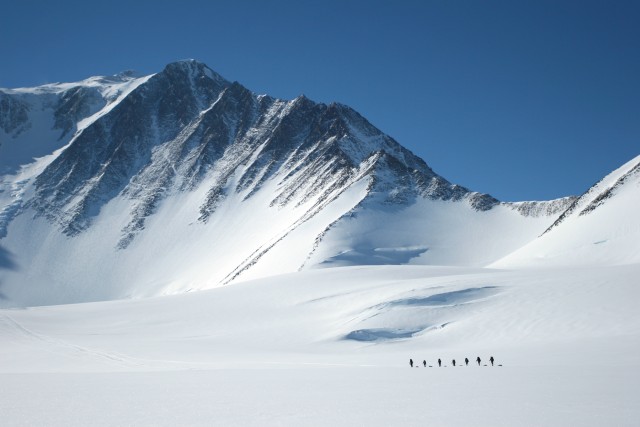Vinson Massif
VINSON MASSIF IS THE highest peak (16,077 ft or 4,901 m) on the ANTARCTICA continent. It forms the southern outlier of the Sentinel Range, the northern range of the Ellsworth Mountains. The Ellsworth Mountains, divided into the Sentinel Range and the Heritage Range by the Minnesota Glacier, lie in the eastern part of Ellsworth Land, inland from the Ronne Ice Shelf. Vinson Massif is 13 mi (21 km) long and 8 mi (13 km) wide.
The Sentinel Range was first sighted by U.S. aviator Lincoln Ellsworth in November 1935; however, he did not actually sight Vinson Massif itself. Between 1958 and 1961, the U.S. Navy completed ground surveys and aerial photographs of the region from Byrd Station. It is believed that on these reconnaissance flights, Vinson Massif was first sighted. From the data collected, scientists mapped the area, labeling heights and naming peaks throughout the Sentinel Range.

Vinson Massif was named for Republican Congressman Carl G. Vinson of Georgia. From the time of Admiral Richard Byrd's Second U.S. Expedition of 1933–35, Vinson had a great interest in and was a vigorous campaigner for America's official involvement in Antarctic exploration and research. Initially, the peak was calculated at 16,859 ft (5,140 m), using traverse data from the survey of the major peaks in the Sentinel Range. In 1979, these peaks were resurveyed, placing markers on the massif and comparing them to satellite data. As a result, corrected data showed Vinson Massif's height to be 16,062 ft or 4,897 m; however, recent further examination using new satellite data has revealed an additional difference of 15 ft (4 m).
The first ascent of Vinson Massif occurred on December 18, 1966, when the team of Barry Corbet, John Evans, William Long, and Peter Schoening reached the summit. Between December 18 and 20, 10 members of the American Antarctic Expedition, led by Nicholas Clinch, reached the summit in three separate ascents. The 1966 American Antarctic Expedition was organized by the American Alpine Club, under the auspices of the National Science Foundation. It was financially supported by the National Geographic Society and logistically supported by the U.S. Navy.
This expedition also made successful first ascents of many other peaks in the region and is one of few government-supported expeditions to Antarctica organized specifically for mountaineering. From the first ascent, mountaineering has been the major activity on Vinson Massif.